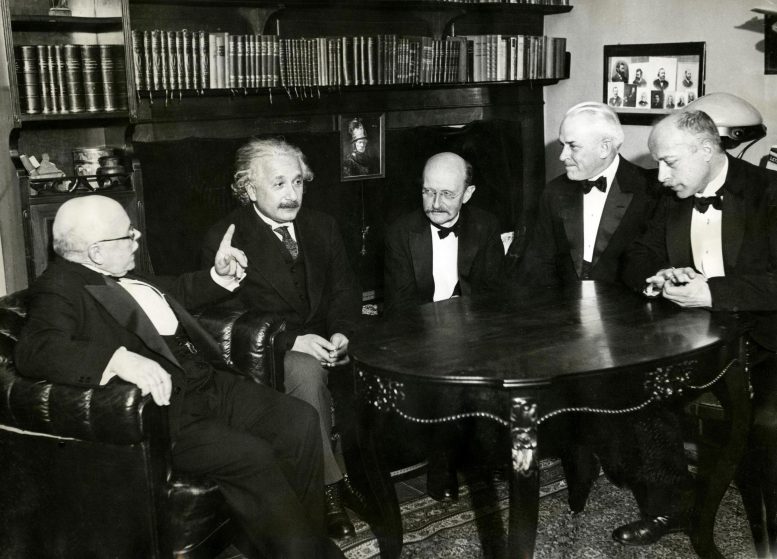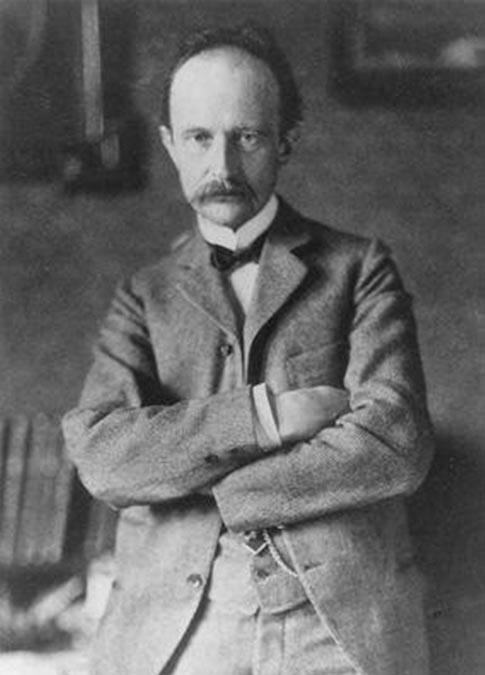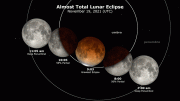
From left to right: Walther Nernst, Albert Einstein, Max Planck, Robert Andrews Millikan, and Max von Laue at a dinner given by von Laue on November 12, 1931, in Berlin.
In the early evening of Sunday, October 7, 1900—120 years ago—Max Planck found the functional form of the curve that we now know as the Planck distribution of black-body radiation. By my account, it was the birthdate of quantum mechanics.
A few hours earlier Hermann Rubens and his wife had visited the Plancks. This being a Sunday, they probably enjoyed coffee and cake together. Rubens was the experimental professor of physics at Humboldt University in Berlin where Planck was the theoretical one. Rubens and his collaborator, Ferdinand Kurlbaum, had recently managed to measure the power emitted by a black body as a function of temperature at the unusually long wavelength of 51 microns. They had used multiple reflections from rock salt to filter a narrow band of the spectrum. Working at 51 microns, they measured the low-temperature limit and the highest temperatures within the experimental reach of their oven. The remarkable result was that at low frequencies, in the classical regime, the results did not fit the predictions of Wilhelm Wien. Rubens told Planck that for small frequencies the measured spectral density was linear with temperature.
Planck was intrigued. As soon as the gathering ended, he set to work. His interest in the data was profound. That evening he figured out the shape of the curve, with its peculiar denominator that in the limit of low frequency showed the appropriate experimental behavior—linear with temperature.
The anecdote, as referred by Abraham Pais in his book Subtle is the Lord, states that Planck mailed a postcard to Rubens with the function that very evening, so that Rubens would get it first thing in the morning (the post would have been delivered and set on his desk by the time he arrived at his office in the university). Rubens probably asked Planck that very same morning: Why is it this shape?
The presentation of new data, followed by Planck’s function, was on October 17. The function fit the data, both at the low-temperature and high-temperature limits. Planck had been interested in the black body spectrum for a long time. He understood thermodynamics and classical electrodynamics. But it was the high-quality data of Rubens that drove his mind to find a solution. It took him a few months, and on December 14 he presented the derivation of his theory where, “on an act of desperation,” he introduced the quantum of energy: the beginning of quantum mechanics.
In memory of Mario Molina.
This historical note was written by JQI Fellow Luis Orozco.










This is a nice story. However, I would have liked elucidated more of the logical considerations surrounding black-body radiation entertained by Planck and Rubens at the time. Maybe some commentary on why it’s so interesting to any scientist (let alone the greats of the past). Maybe some more context on that Dec 17th presentation as well.
Measuring the heat added to a target per unit of time by radiation at 51 microns, using simple equipment, represents careful and ambitious lab science. The success of extending the measurement to such a comparatively long wavelength in the infrared rendered the behavior of the experimental distribution function clearer than ever. Thus Plank’s work was cut out for him in trying to predict the distribution analytically based on a theoretical model.
This makes the story told here more compelling than ever.
,,, The issue with some parts of relativity is that it looks so great at the very first glance, however, later, some parts really look absurd!